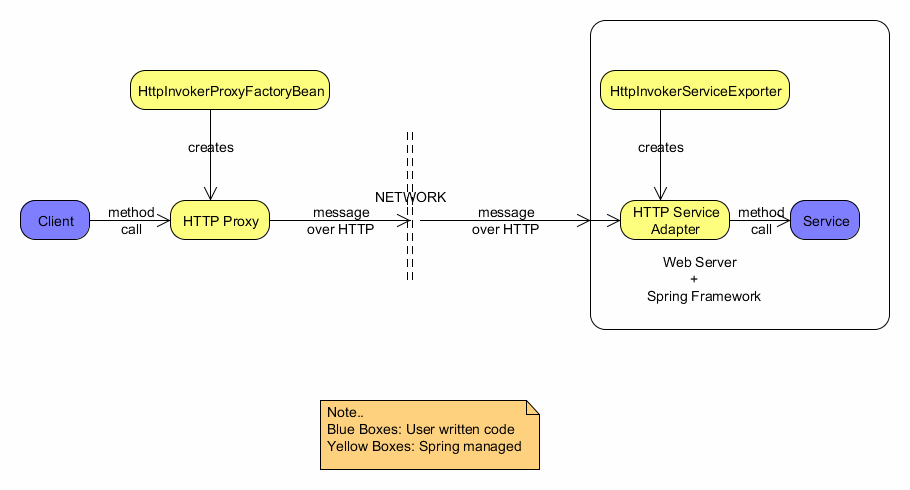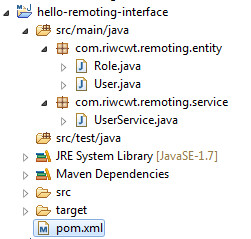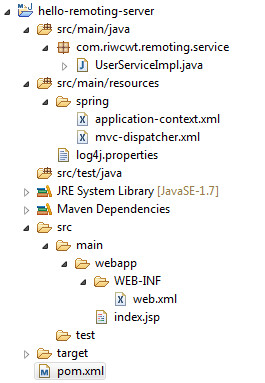在最近给客户做的两个系统之间,有一些需要相互调用的地方,因为两个系统的架构基本相同,都是采用的spring mvc + mybatis,所以尝试使用了一下spring httpinvoker。目前系统访问平稳,用户量也不是很大,没有出现什么问题。
现在常见的远程调用,主要有RMI、 spring httpinvoker、 hessian、 burlap、 web services、 protobuf等。各种方式都有自己的优缺点,网上有很多相关的对比,这里就不再赘述。但是对于两个都是java开发的系统而言,spring httpinvoker应该是综合了传输效率和开发效率的比较好的方式。
spring invoker调用流程图

spring httpinvoker示例
使用了maven开发,三个工程:
hello-remoting-interface
hello-remoting-server
hello-remoting-client
hello-remoting-interface
定义接口和使用到的实体

pom.xml文件
<project xmlns="http://maven.apache.org/POM/4.0.0" xmlns:xsi="http://www.w3.org/2001/XMLSchema-instance"
xsi:schemaLocation="http://maven.apache.org/POM/4.0.0 http://maven.apache.org/maven-v4_0_0.xsd">
<modelVersion>4.0.0</modelVersion>
<groupId>com.riwcwt</groupId>
<artifactId>hello-remoting-interface</artifactId>
<packaging>jar</packaging>
<version>1.0-SNAPSHOT</version>
<name>hello-httpinvoker-interface</name>
<url>http://maven.apache.org</url>
<properties>
<spring.version>3.2.10.RELEASE</spring.version>
</properties>
<dependencies>
<dependency>
<groupId>org.springframework</groupId>
<artifactId>spring-core</artifactId>
<version>${spring.version}</version>
</dependency>
<dependency>
<groupId>org.springframework</groupId>
<artifactId>spring-context</artifactId>
<version>${spring.version}</version>
</dependency>
<dependency>
<groupId>org.springframework</groupId>
<artifactId>spring-web</artifactId>
<version>${spring.version}</version>
</dependency>
<dependency>
<groupId>org.springframework</groupId>
<artifactId>spring-webmvc</artifactId>
<version>${spring.version}</version>
</dependency>
<dependency>
<groupId>org.slf4j</groupId>
<artifactId>slf4j-log4j12</artifactId>
<version>1.7.7</version>
</dependency>
<dependency>
<groupId>junit</groupId>
<artifactId>junit</artifactId>
<version>4.11</version>
<scope>test</scope>
</dependency>
<dependency>
<groupId>org.springframework</groupId>
<artifactId>spring-test</artifactId>
<version>${spring.version}</version>
</dependency>
<dependency>
<groupId>org.apache.httpcomponents</groupId>
<artifactId>httpclient</artifactId>
<version>4.3.5</version>
</dependency>
</dependencies>
</project>UserService.java
package com.riwcwt.remoting.service;
import java.util.List;
import com.riwcwt.remoting.entity.Role;
import com.riwcwt.remoting.entity.User;
public interface UserService
{
public List<User> getAllUsers();
public List<Role> getRolesByUser(User user);
}hello-remoting-server
服务提供方

web.xml
<!DOCTYPE web-app PUBLIC "-//Sun Microsystems, Inc.//DTD Web Application 2.3//EN" "http://java.sun.com/dtd/web-app_2_3.dtd" >
<web-app>
<display-name>Archetype Created Web Application</display-name>
<context-param>
<param-name>contextConfigLocation</param-name>
<param-value>classpath:spring/*-context.xml</param-value>
</context-param>
<!-- 防止发生java.beans.Introspector内存泄露,应将它配置在ContextLoaderListener的前面 -->
<listener>
<listener-class>org.springframework.web.util.IntrospectorCleanupListener</listener-class>
</listener>
<listener>
<listener-class>org.springframework.web.context.ContextLoaderListener </listener-class>
</listener>
<!-- 设置WEB应用字符集,也是通过过滤器完成的 -->
<filter>
<filter-name>CharacterEncodingFilter</filter-name>
<filter-class>org.springframework.web.filter.CharacterEncodingFilter</filter-class>
<init-param>
<param-name>encoding</param-name>
<param-value>UTF-8</param-value>
</init-param>
<init-param>
<param-name>forceEncoding</param-name>
<param-value>true</param-value>
</init-param>
</filter>
<filter-mapping>
<filter-name>CharacterEncodingFilter</filter-name>
<url-pattern>/*</url-pattern>
</filter-mapping>
<!-- Spring MVC 的Servlet,它将加载WEB-INF/mvc-dispatcher.xml 的 配置文件, 以启动Spring
MVC模块 -->
<servlet>
<servlet-name>mvc</servlet-name>
<servlet-class>org.springframework.web.servlet.DispatcherServlet</servlet-class>
<init-param>
<param-name>contextConfigLocation</param-name>
<param-value>classpath*:spring/mvc-dispatcher.xml</param-value>
</init-param>
<load-on-startup>1</load-on-startup>
</servlet>
<servlet-mapping>
<servlet-name>mvc</servlet-name>
<url-pattern>/</url-pattern>
</servlet-mapping>
<welcome-file-list>
<welcome-file>/index.jsp</welcome-file>
</welcome-file-list>
</web-app>UserServiceImpl.java
package com.riwcwt.remoting.service;
import java.util.LinkedList;
import java.util.List;
import org.apache.log4j.Logger;
import org.springframework.stereotype.Service;
import com.riwcwt.remoting.entity.Role;
import com.riwcwt.remoting.entity.User;
@Service(value = "userService")
public class UserServiceImpl implements UserService
{
private static Logger logger = Logger.getLogger(UserServiceImpl.class);
@Override
public List<User> getAllUsers()
{
logger.info("invoke the first one");
List<User> users = new LinkedList<User>();
for (int i = 0; i < 2; i++)
{
User user = new User();
user.setUsername("username " + i);
user.setDescription("description " + i);
List<Role> roles = new LinkedList<Role>();
Role admin = new Role();
admin.setRoleName("amin");
Role manager = new Role();
manager.setRoleName("manager");
roles.add(admin);
roles.add(manager);
user.setRoles(roles);
users.add(user);
}
return users;
}
@Override
public List<Role> getRolesByUser(User user)
{
logger.info("invoke the second one");
List<Role> roles = new LinkedList<Role>();
Role admin = new Role();
admin.setRoleName("amin");
Role manager = new Role();
manager.setRoleName("manager");
roles.add(admin);
roles.add(manager);
return roles;
}
}mvc-dispatcher.xml
<?xml version="1.0" encoding="UTF-8"?>
<beans xmlns="http://www.springframework.org/schema/beans"
xmlns:xsi="http://www.w3.org/2001/XMLSchema-instance" xmlns:aop="http://www.springframework.org/schema/aop"
xmlns:lang="http://www.springframework.org/schema/lang" xmlns:context="http://www.springframework.org/schema/context"
xmlns:mvc="http://www.springframework.org/schema/mvc" xmlns:p="http://www.springframework.org/schema/p"
xsi:schemaLocation="
http://www.springframework.org/schema/beans
http://www.springframework.org/schema/beans/spring-beans.xsd
http://www.springframework.org/schema/aop
http://www.springframework.org/schema/aop/spring-aop.xsd
http://www.springframework.org/schema/lang
http://www.springframework.org/schema/lang/spring-lang.xsd
http://www.springframework.org/schema/context
http://www.springframework.org/schema/context/spring-context.xsd
http://www.springframework.org/schema/mvc
http://www.springframework.org/schema/mvc/spring-mvc.xsd">
<!-- 设置使用注解的类所在的jar包 -->
<context:component-scan base-package="com.riwcwt.remoting.service"></context:component-scan>
<bean name="/user-service"
class="org.springframework.remoting.httpinvoker.HttpInvokerServiceExporter">
<property name="service" ref="userService" />
<property name="serviceInterface" value="com.riwcwt.remoting.service.UserService" />
</bean>
</beans>hello-remoting-client
客户端调用服务
application-context.xml
<?xml version="1.0" encoding="UTF-8" standalone="no"?>
<beans xmlns="http://www.springframework.org/schema/beans"
xmlns:aop="http://www.springframework.org/schema/aop" xmlns:context="http://www.springframework.org/schema/context"
xmlns:jdbc="http://www.springframework.org/schema/jdbc" xmlns:jee="http://www.springframework.org/schema/jee"
xmlns:tx="http://www.springframework.org/schema/tx" xmlns:jpa="http://www.springframework.org/schema/data/jpa"
xmlns:xsi="http://www.w3.org/2001/XMLSchema-instance"
xsi:schemaLocation="
http://www.springframework.org/schema/aop
http://www.springframework.org/schema/aop/spring-aop.xsd
http://www.springframework.org/schema/beans
http://www.springframework.org/schema/beans/spring-beans.xsd
http://www.springframework.org/schema/context
http://www.springframework.org/schema/context/spring-context.xsd
http://www.springframework.org/schema/jee
http://www.springframework.org/schema/jee/spring-jee.xsd
http://www.springframework.org/schema/tx
http://www.springframework.org/schema/tx/spring-tx.xsd
http://www.springframework.org/schema/jdbc
http://www.springframework.org/schema/jdbc/spring-jdbc.xsd
http://www.springframework.org/schema/data/jpa
http://www.springframework.org/schema/data/jpa/spring-jpa.xsd">
<!-- 导入属性配置文件 -->
<context:property-placeholder location="classpath*:remoting.properties" />
<bean id="userService"
class="org.springframework.remoting.httpinvoker.HttpInvokerProxyFactoryBean">
<property name="serviceUrl"
value="http://${remoting.host}:${remoting.port}/${remoting.context}/user-service">
</property>
<property name="serviceInterface" value="com.riwcwt.remoting.service.UserService">
</property>
<!-- 修改默认的HTTP请求链接方式,提升连接效率 -->
<property name="httpInvokerRequestExecutor">
<bean
class="org.springframework.remoting.httpinvoker.HttpComponentsHttpInvokerRequestExecutor">
</bean>
</property>
</bean>
</beans>测试用例代码
package com.riwcwt.remoting.service;
import java.util.List;
import javax.annotation.Resource;
import org.junit.Test;
import org.junit.runner.RunWith;
import org.springframework.test.context.ContextConfiguration;
import org.springframework.test.context.junit4.SpringJUnit4ClassRunner;
import com.riwcwt.remoting.entity.Role;
import com.riwcwt.remoting.entity.User;
@RunWith(SpringJUnit4ClassRunner.class)
@ContextConfiguration("/spring/application-context.xml")
public class UserServiceTest
{
@Resource(name = "userService")
private UserService userService = null;
@Test
public void testGetAllUsersByHttpInvoker() throws InterruptedException
{
List<User> users = this.userService.getAllUsers();
for (User user : users)
{
System.out.println(user.getUsername() + " " + user.getDescription());
for (Role role : user.getRoles())
{
System.out.println(role.getRoleName());
}
}
}
@Test
public void anotherTest()
{
for (int i = 0; i < 5; i++)
{
User user = new User();
user.setUsername("test");
List<Role> roles = this.userService.getRolesByUser(user);
for (Role role : roles)
{
System.out.println(role.getRoleName());
}
}
}
}server和client工程都依赖于interface工程,这样就方便于开发。通过上面的例子,可以看出spring httpinvoker是很方便于做远程调用的,其实spring对于rmi、hessian、burlap也提供了几乎和上面配置一样的调用,只是serviceexpoter和factoorybean不同,这里就不再一一做示例。






















 3724
3724

 被折叠的 条评论
为什么被折叠?
被折叠的 条评论
为什么被折叠?








